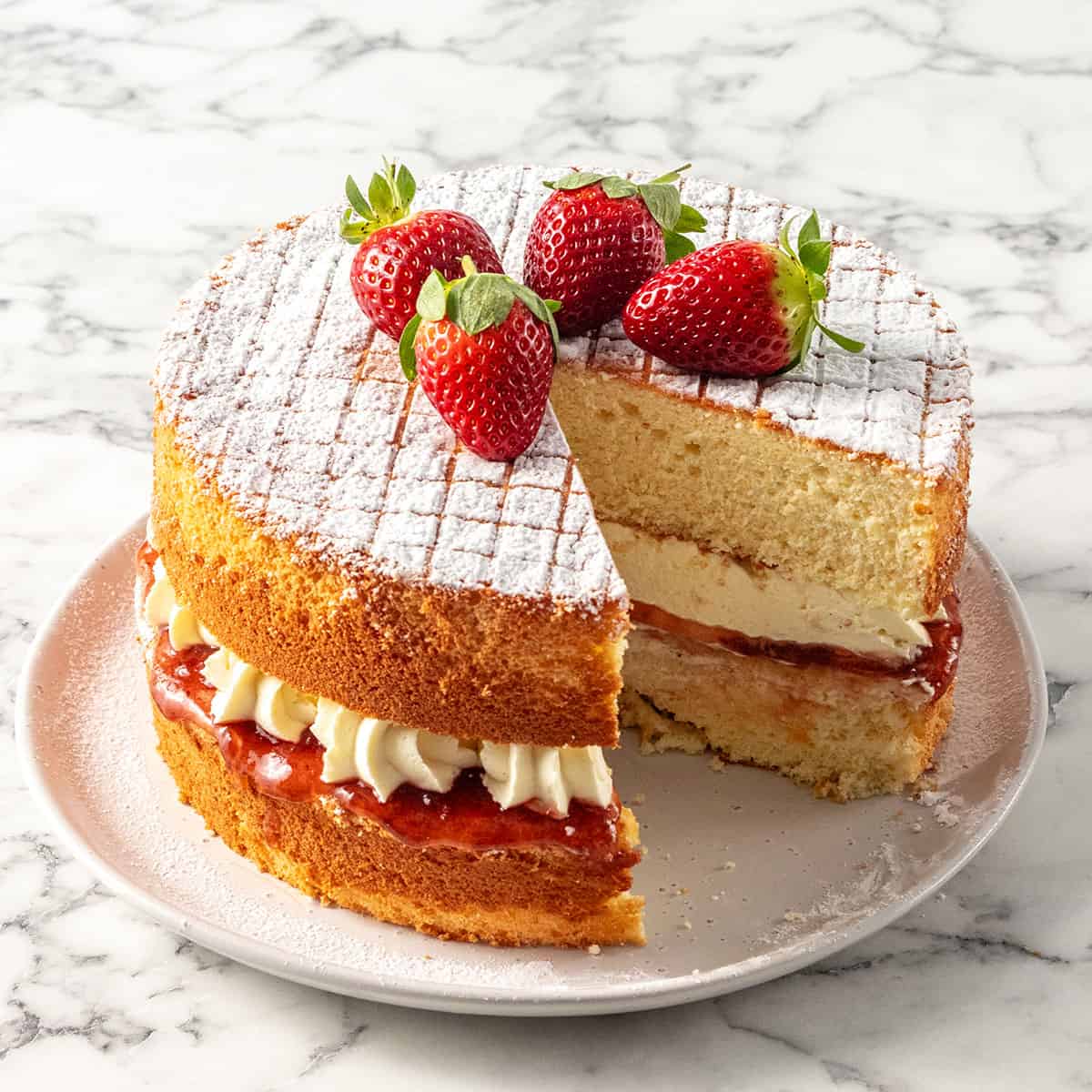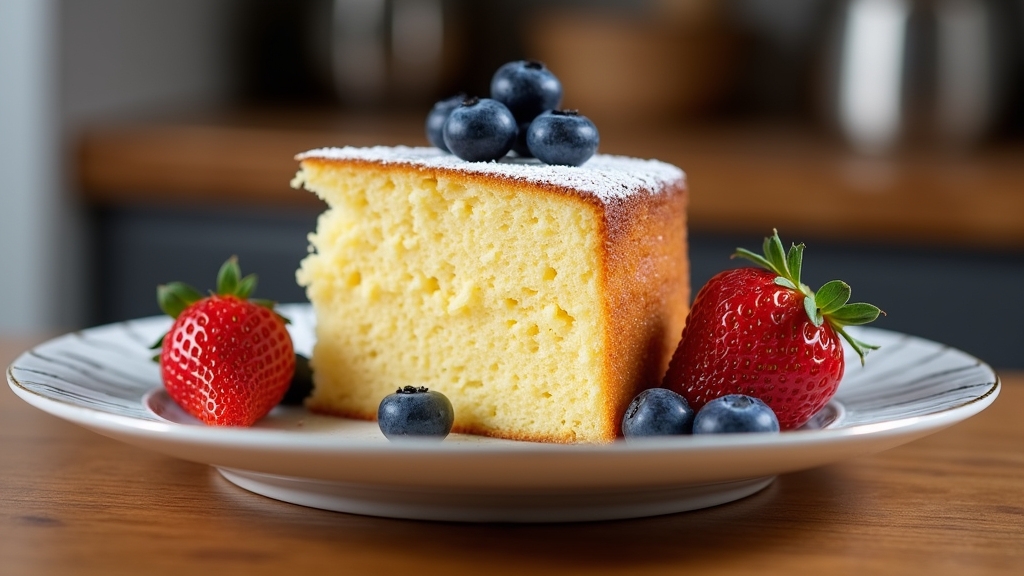I’ve found a delightful sponge cake recipe that’s sure to impress! You’ll need 4 eggs, 1 cup of sugar, 1 cup of flour, 1 teaspoon of baking powder, and a few other simple ingredients. The key is to whisk the eggs and sugar until they’re pale and thick for that light, fluffy texture. Bake at 350°F for 25-30 minutes, and you’ll have a delicious dessert. Stick around, and I’ll share some fun flavor ideas and serving tips!
History
When I investigate the history of sponge cake, I find it fascinating how this light, airy dessert has evolved over centuries. Originating in the 16th century, sponge cake marked a significant moment in culinary evolution, illustrating how simple ingredients can create something extraordinary. Its rise in popularity coincided with advancements in baking technology, particularly the introduction of baking powder.
This dessert not only showcases culinary innovation but also embodies cultural significance, often gracing celebration tables across various cultures. From Italian Pan di Spagna to the British Victoria sponge, each iteration reflects local flavors and traditions, uniting people through shared experiences. As I probe deeper, I’m continually inspired by how sponge cake bridges history and modern taste.
Recipe
Sponge cake is a light and airy dessert that is perfect for any occasion, from birthday celebrations to afternoon tea. With its simple ingredients and straightforward preparation, it is a favorite among bakers of all skill levels. This cake relies on the incorporation of air into the batter, creating a fluffy texture that makes it a delightful treat on its own or as a base for layered cakes and desserts.
To achieve the best results, it is crucial to use room temperature ingredients, as this helps in achieving the desired volume and consistency. The key to a successful sponge cake is whipping the eggs and sugar together until they are pale and thick, which will provide the necessary structure and height. The final addition of flour should be done gently to maintain the aeration achieved during mixing.
Ingredients:
- 4 large eggs
- 1 cup granulated sugar
- 1 cup all-purpose flour
- 1 teaspoon baking powder
- 1/4 teaspoon salt
- 1/4 cup unsalted butter, melted
- 1 teaspoon vanilla extract
Cooking Instructions:
Preheat your oven to 350°F (175°C) and grease a 9-inch round cake pan. In a large bowl, whisk together the eggs and granulated sugar until pale and thick, about 5-7 minutes. Sift the all-purpose flour, baking powder, and salt together, then gently fold into the egg mixture using a spatula. Carefully add the melted butter and vanilla extract, mixing until just combined. Pour the batter into the prepared cake pan and bake for 25-30 minutes or until a toothpick inserted in the center comes out clean. Allow the cake to cool in the pan for a few minutes before transferring it to a wire rack to cool completely.
Extra Tips:
For the best sponge cake, confirm that all your ingredients are at room temperature, as this helps them blend more easily and promotes better aeration. When whipping the eggs and sugar, be patient and confirm they are fully combined and have reached a thick, ribbon-like texture before adding the dry ingredients. Use a gentle folding motion when incorporating the flour to avoid deflating the batter. Additionally, if you’d like to add flavor variations, consider incorporating citrus zest or almond extract for a delightful twist.
Cooking Steps
Before we get started on making that perfect sponge cake, I always preheat my oven to 350°F to guarantee an even bake. Next, I whisk together the eggs and sugar until they’re light and fluffy, setting the stage for a delightful texture. Once that’s done, I gently fold in the flour and add a splash of vanilla extract to elevate the flavor before it all goes into the oven for 25 minutes of magic.
Step 1. Preheat the Oven to 350°F
To kick off our sponge cake adventure, I always preheat the oven to 350°F, ensuring it’s ready to create the perfect rise. This oven temperature is essential because it provides the ideal environment for the cake to expand and develop that light, airy texture we all crave. While the oven warms up, I gather my ingredients, allowing them to reach room temperature—another baking tip I swear by.
This simple step helps in achieving a consistent batter, making for a fluffier cake. I also recommend using an oven thermometer to confirm the accuracy of your oven temperature; it can make all the difference in your baking results. With everything prepped, I’m ready to move on to the next exciting step!
Step 2. Whisk Eggs and Sugar
The moment has arrived to whisk the eggs and sugar, an essential step that sets the foundation for our sponge cake. This mixture not only creates volume but also infuses air, guaranteeing a light texture. Here’s how I tackle this vital task:
- Choose Your Egg Whisking Techniques: I prefer using a hand whisk for better control, but an electric mixer can save time—just make sure you start slow to avoid splatter.
- Incorporate Sugar Gradually: I add sugar in three stages, allowing it to dissolve fully between each addition. This technique enhances the mixture’s aeration.
- Whisk Until Smooth and Pale: I continue whisking until the eggs are frothy and have nearly tripled in volume, a sign that the sponge cake will rise beautifully.
Step 3. Fold in Flour Gently
Once I’ve achieved that perfect egg and sugar mixture, it’s time to fold in the flour gently, a step vital for maintaining the airy texture we’ve worked so hard to create. I prefer using cake flour for its fine texture, which blends seamlessly, but all-purpose flour can work too. With a rubber spatula, I employ careful folding techniques—scooping from the bottom and bringing the mixture up and over. This motion preserves the air bubbles formed during whisking, allowing the cake to rise beautifully. I avoid stirring vigorously, as that would deflate our hard-earned volume. It’s essential to fold until just combined; a few specks of flour are okay. This delicate balance is the key to a light, fluffy sponge cake!
Step 4. Add Vanilla Extract
As I prepare to add the vanilla extract, I can already imagine the delightful aroma it will bring to my sponge cake. This isn’t just any vanilla; it’s sourced from the lush bean pods that have traveled from tropical regions, highlighting the rich vanilla origins. Adding this flavor enhancement elevates the overall experience, marrying seamlessly with the lightness of the sponge.
Here’s how I do it:
- Measure out 1 to 2 teaspoons of pure vanilla extract.
- Gently pour it into the batter, ensuring it disperses evenly.
- Stir with a spatula, allowing that exquisite aroma to fill the kitchen.
This small step transforms my sponge cake into a fragrant masterpiece, ready to impress everyone!
Step 5. Bake for 25 Minutes
With the vanilla extract beautifully incorporated, it’s time to send my sponge cake into the oven. I preheat it to 350°F (175°C), ensuring the heat is just right for my baking techniques to shine. As I pour the batter into a greased pan, I can already envision the fluffy, airy texture that’s characteristic of a perfect sponge.
I place it on the center rack, knowing that even slight variations in time can affect the outcome. I set a timer for 25 minutes, resisting the urge to peek too soon. During this essential time, the cake will rise and set beautifully. Once it’s golden and springs back when touched, I’ll have a delightful canvas for all sorts of cake variations.
Nutritional Guide
While indulging in a slice of sponge cake, I often find myself curious about its nutritional value. Understanding the caloric content and ingredient benefits can enhance our enjoyment. Here’s a quick guide to the key components:
| Ingredient | Caloric Content (per slice) | Benefits |
|---|---|---|
| Flour | 95 calories | Provides carbohydrates for energy |
| Sugar | 50 calories | Quick energy boost and enhances flavor |
| Eggs | 70 calories | Rich in protein, aids in muscle repair |
| Butter | 100 calories | Adds richness and healthy fats |
Final Thoughts
Enjoying a slice of sponge cake can be a delightful experience, especially when you appreciate the balance of flavors and textures it offers. To elevate your sponge cake journey, consider these baking tips and serving suggestions:
- Experiment with Flavors: Try adding citrus zest or vanilla bean for a unique twist that excites the palate.
- Layer it Up: Use the sponge as a base for layered desserts; think fresh fruits, whipped cream, or even a rich chocolate ganache.
- Garnish Thoughtfully: A dusting of powdered sugar or a drizzle of glaze can add that perfect finishing touch, enhancing both taste and presentation.
Baking sponge cake is an art, and I hope these insights inspire your next creation in the kitchen!
Frequently Asked Questions
Can I Substitute Eggs in a Sponge Cake Recipe?
I’ve used egg alternatives like applesauce or flaxseed meal in my vegan sponge. They work wonders, adding moisture and binding while keeping the texture light. Don’t hesitate to experiment for delicious results!
What Type of Flour Works Best for Sponge Cake?
When I baked a cake for my friend’s wedding, I discovered that cake flour creates a light, airy texture. Using this flour type really elevated the dessert, making it unforgettable and perfect for special occasions.
How Can I Prevent My Sponge Cake From Sinking?
To prevent my sponge cake from sinking, I guarantee I mix the batter gently to maintain airiness and bake at the right temperature. Both techniques are essential for achieving that perfect, fluffy rise I crave!
Can I Freeze Leftover Sponge Cake?
Absolutely, you can freeze leftover sponge cake! I use simple freezing techniques like wrapping it tightly in plastic wrap. For storage tips, label it with the date to guarantee I enjoy it fresh later.
What Flavors Can I Add to a Sponge Cake?
You’d think a plain sponge cake couldn’t get any more exciting, but I’ve discovered flavor extracts and fruit purees can transform it. Try vanilla, almond, or raspberry for a delightful twist that’ll surprise everyone!
Conclusion
As I pull the golden sponge cake from the oven, it feels like a warm embrace, a soft cloud of sweetness ready to lift our spirits. Each slice is a reminder that simple ingredients can create something extraordinary, much like the moments we cherish in life. Just as the cake rises with patience and care, so too do our dreams flourish when nurtured. So, let’s savor every bite and every moment, for each is a delightful celebration of joy.

Sponge Cake Recipe
Ingredients
Equipment
Method
- Preheat oven to 350°F (175°C).
- Line cake pan with parchment; do not grease (helps cake climb pan walls).
- In a large bowl, beat eggs and sugar with an electric mixer on high speed for 8–10 minutes until pale, thick, and tripled in volume (ribbon stage).
- Sift flour and salt over egg mixture in 3 batches. Gently fold with a spatula after each addition.
- Add vanilla (and melted butter, if using) with the last flour batch.
- Pour batter into pan; tap once to remove bubbles.
- Bake 20–25 minutes until golden and springs back when touched.
- Invert pan onto a wire rack immediately to prevent sinking. Cool completely before removing parchment.
Notes
- Room-Temp Eggs are critical for maximum volume.
- No Peeking! Avoid opening the oven during baking.
-
Variations:
- Lemon: Add zest of 1 lemon to batter.
- Chocolate: Replace ¼ cup flour with cocoa powder.
- Storage: Keep airtight for 3 days, or freeze unfrosted layers for 1 month.
- Pro Tip: For extra moisture, brush cooled layers with simple syrup before frosting.

